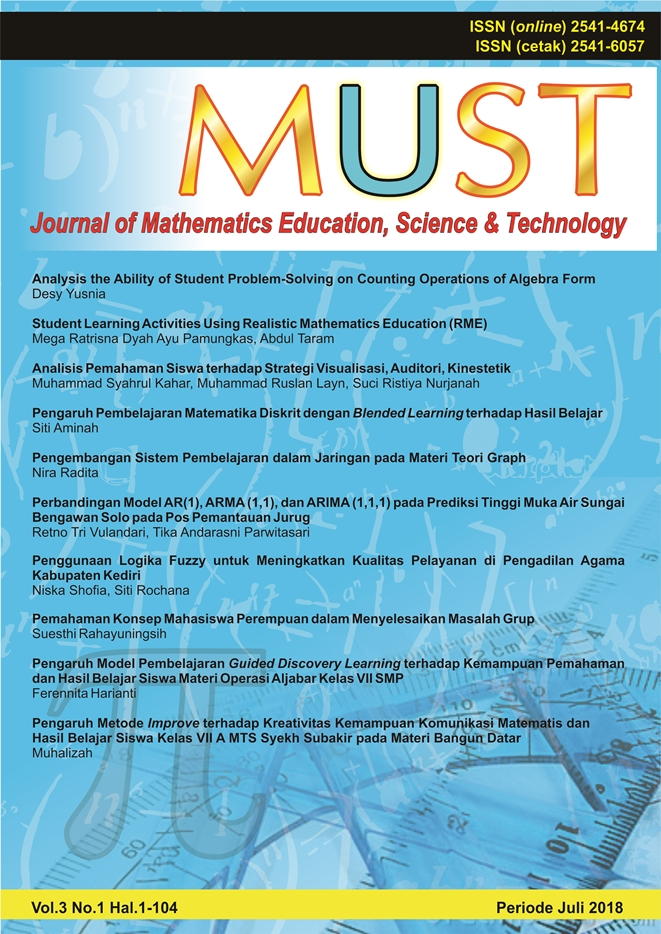Analysis The Ability of Students Problem-Solving on Counting Operations of Algebra Form
Abstract
Problem-solving is the important part of mathematics curriculum. Most of students still have difficulties and error in prombelm solving. This research aims to know problem-solving ability of students on counting operations of algebra form. This research is a descriptive qualitative research. The subject is students grade VII-F SMP N 1 Wonosari. The data collecting technique is a problem-solving test. The data analysis according to Miles and Huberman, which is data reduction, data presentation, and making the conclusion. The results of this research showing that: (1) 95.56% of students can understand the problem, 4.44% of students cannot understand the problem; (2) 18.33% of students can devising a plan, 81.67% cannot devising a plan; (3) 28.61% of students can carrying out the plan, 71.39% cannot carrying out the plan; (4) 45% can looking back the answer, 55% cannot looking back the answer.
Full text article
References
Abdullah, A. H., Abidin, N. L. Z., & Ali, M. (2015). Analysis of students’ errors in solving Higher Order Thinking Skills (HOTS) problems for the topic of a fraction. Asian Social Science Journal Volume 11, Number 21, 2015. Retrieved from https://doi.org/10.5539/ass.v11n21p133
Lester, F. K. (2013). The Mathematics Enthusiast Thoughts About Research On Mathematical Problem-Solving Instruction. The Mathematics Enthusiast Volume 10, Number 10, 2013. Retrieved from https://doi.org/ISSN 1551-3440
Miles, Matthew B. dan A. Micheal Huberman. 2014. “Analisis Data Kualitatifâ€: Buku Sumber Tentang Metode-Metode Baru. Jakarta: Universitas Indoneisa Press.
Ninik, Hobri, & Suharto. Analisis Kemampuan Pemecahan Masalah untuk Setiap Tahap Model Polya dari Siswa SMK Ibu Pakusari Jurusan Multimedia pada Pokok Bahasan Program Linier. Jurnal Kadikma Volum 5, Nomor 3. Desember 2014.
Polya, G. (1973). “How to Solve Itâ€: A New Aspect of Mathematical Method. Princeton: Princeton University Press.
Supianto, et al. Error Analysis Of Students Working About Word Problem Of Linear Program With NEA Procedure. Jurnal of Physics Volume 1, 2017. Retrieved from http://iopscience.iop.org/article/10.1088/1742-6596/855/1/012043/pdf
Tambychik & Meerah. Students’ Difficulties in Mathematics Problem-Solving: What do they Say?. Procedia Social and Behavioral Siences Volume 8. 2010. Retrieved from www.sciencedirect.com
Wardono, & Mariani, S. The Realistic Learning Model With Character Education And PISA AssessmentTo Improve Mathematics Literacy. International Journal of Education and Research Volume 2, Number 7, 2014. Retrieved from http://www.ijern.com/journal/July-2014/30.pdf
White, A. L. Diagnostic and Pedagogical Issues with Mathematical Word Problems. Brunei Int. J. of Sci. & Math. Edu Volume 1, Number 1. 2009. Retrieved from
https://shbieejournal.files.wordpress.com/2009/11/awhite_2009bijsmepdf.pdf
Authors
Authors who publish with this journal agree to the following terms:
- Authors retain copyright and grant the journal right of first publication with the work simultaneously licensed under a Creative Commons Attribution-NonCommercial 4.0 International License that allows others to share the work with an acknowledgment of the work's authorship and initial publication in this journal.
- Authors are able to enter into separate, additional contractual arrangements for the non-exclusive distribution of the journal's published version of the work (e.g., post it to an institutional repository or publish it in a book), with an acknowledgment of its initial publication in this journal.
- Authors are permitted and encouraged to post their work online (e.g., in institutional repositories or on their website) prior to and during the submission process, as it can lead to productive exchanges, as well as earlier and greater citation of published work

